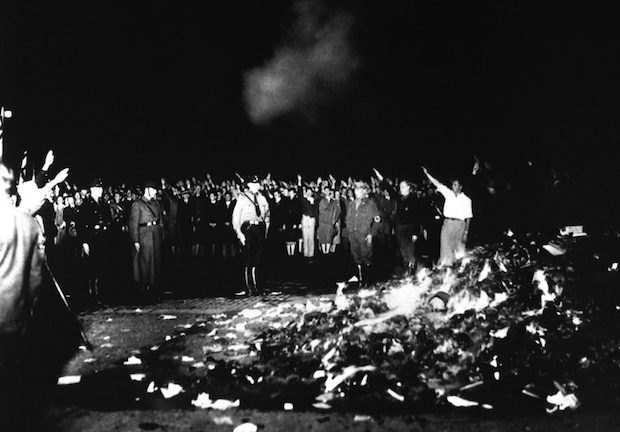‘Destroy That Art!’ Cried The Woke Artists

In the current Whitney Biennial, a very big-deal art show in New York, there is a 2016 painting depicting the body of Emmett Till, the Mississippi teenager murdered by white supremacists in 1955. Artist Dana Schutz, who is white, created the highly abstract image from famous open-casket photographs of Till at his funeral. Till’s mother wanted the world to see what white supremacists had done to her son. Those photographs served as a catalyst for civil rights protest, and are now an icon of American history.
Schutz’s painting has been denounced by some black artists and others, because the painter is white. Hannah Black, a British-born black artist, has written an open letter demanding that the Whitney Museum not only take the painting down, but also destroy it. Here is the full text of her letter, which is drawing a number of signers:
OPEN LETTER
To the curators and staff of the Whitney biennial:
I am writing to ask you to remove Dana Schutz’s painting “Open Casket” and with the urgent recommendation that the painting be destroyed and not entered into any market or museum.
As you know, this painting depicts the dead body of 14-year-old Emmett Till in the open casket that his mother chose, saying, “Let the people see what I’ve seen.” That even the disfigured corpse of a child was not sufficient to move the white gaze from its habitual cold calculation is evident daily and in a myriad of ways, not least the fact that this painting exists at all. In brief: the painting should not be acceptable to anyone who cares or pretends to care about Black people because it is not acceptable for a white person to transmute Black suffering into profit and fun, though the practice has been normalized for a long time.
Although Schutz’s intention may be to present white shame, this shame is not correctly represented as a painting of a dead Black boy by a white artist — those non-Black artists who sincerely wish to highlight the shameful nature of white violence should first of all stop treating Black pain as raw material. The subject matter is not Schutz’s; white free speech and white creative freedom have been founded on the constraint of others, and are not natural rights. The painting must go.
Emmett Till’s name has circulated widely since his death. It has come to stand not only for Till himself but also for the mournability (to each other, if not to everyone) of people marked as disposable, for the weight so often given to a white woman’s word above a Black child’s comfort or survival, and for the injustice of anti-Black legal systems. Through his mother’s courage, Till was made available to Black people as an inspiration and warning. Non-Black people must accept that they will never embody and cannot understand this gesture: the evidence of their collective lack of understanding is that Black people go on dying at the hands of white supremacists, that Black communities go on living in desperate poverty not far from the museum where this valuable painting hangs, that Black children are still denied childhood. Even if Schutz has not been gifted with any real sensitivity to history, if Black people are telling her that the painting has caused unnecessary hurt, she and you must accept the truth of this. The painting must go.
Ongoing debates on the appropriation of Black culture by non-Black artists have highlighted the relation of these appropriations to the systematic oppression of Black communities in the US and worldwide, and, in a wider historical view, to the capitalist appropriation of the lives and bodies of Black people with which our present era began. Meanwhile, a similarly high-stakes conversation has been going on about the willingness of a largely non-Black media to share images and footage of Black people in torment and distress or even at the moment of death, evoking deeply shameful white American traditions such as the public lynching. Although derided by many white and white-affiliated critics as trivial and naive, discussions of appropriation and representation go to the heart of the question of how we might seek to live in a reparative mode, with humility, clarity, humour and hope, given the barbaric realities of racial and gendered violence on which our lives are founded. I see no more important foundational consideration for art than this question, which otherwise dissolves into empty formalism or irony, into a pastime or a therapy.
The curators of the Whitney biennial surely agree, because they have staged a show in which Black life and anti-Black violence feature as themes, and been approvingly reviewed in major publications for doing so. Although it is possible that this inclusion means no more than that blackness is hot right now, driven into non-Black consciousness by prominent Black uprisings and struggles across the US and elsewhere, I choose to assume as much capacity for insight and sincerity in the biennial curators as I do in myself. Which is to say — we all make terrible mistakes sometimes, but through effort the more important thing could be how we move to make amends for them and what we learn in the process. The painting must go.
Thank you for reading
Hannah Black
Artist/writer
Whitney ISP 2013-14
See the reprint in ArtNews for the names of the co-signers.
So there you have it: prominent artists demanding that a museum not only remove a work of art, but destroy it, because the artist is white, and her subject is black. Think about that. Think about where this is going.